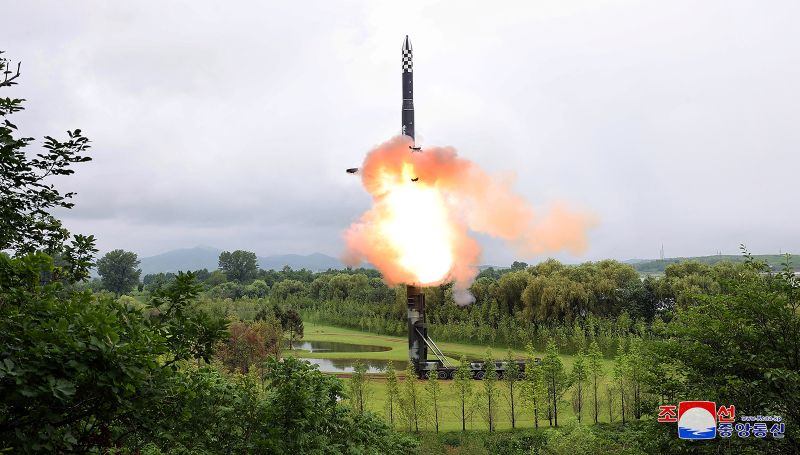
North Korea Conducts Test of Ballistic Missile with Range Capable of Reaching US and Japan, Reports Confirm

North Korea tests a potential intercontinental ballistic missile, signaling advancements in their illicit weapons program, raising concerns regarding its reliability
On Monday morning, North Korea launched a potential intercontinental ballistic missile, leading analysts to believe that the reclusive state's illegal weapons program is becoming increasingly reliable. According to a preliminary assessment from the Japanese Defense Ministry, the missile launched on Monday has the range to potentially strike any location in the United States.
Shingo Miyake, parliamentary vice-minister of defense, reported at a news conference in Tokyo that the ICBM-class ballistic missile launched this time could potentially reach over 15,000 kilometers (9,320 miles) and cover the entirety of US territory. Japanese authorities noted that the missile flew at a highly lofted trajectory for about 73 minutes, reaching an altitude of 6,000 kilometers (3,700 miles) and traveling a distance of about 1,000 kilometers (621 miles) before falling into the sea west of the northern Japanese island of Hokkaido.
Pyongyang would need to launch the missile at a lower trajectory in order to effectively reach the United States. However, this capability has not been demonstrated by North Korea, as noted by Joseph Dempsey, research associate for defense and military analysis at the International Institute for Strategic Studies.
Dempsey explained to CNN that lofted tests may confirm full engine burns and staging, but they do not present the same challenges as a normal ICBM trajectory, including the warhead's ability to survive a prolonged shallower reentry into the atmosphere or its accuracy over longer distances.
Although the type of missile fired was not disclosed, Jeffrey Lewis, a professor at the James Martin Center for Nonproliferation Studies at the Middlebury Institute of International Studies, suggested that Monday's test was likely the third of the Hwasong-18 missile, a powerful solid-fueled ICBM that North Korea had also launched in April and July.
It shows a maturing North Korean missile program, according to Lewis.
"If this is indeed the third successful flight test in a row, that would be a good record of reliability," he told CNN.
"Despite its occasional failed missile tests, North Korea's overall missile reliability is quite commendable," stated Lewis. Following the April test, Kim expressed that the Hwasong-18 would strengthen the country's nuclear capabilities and serve as a formidable strategic weapon.
This photo, released by North Korea's Korean Central News Agency on July 13, 2023, shows the launch of a Hwasong-18 intercontinental ballistic missile from an undisclosed location in North Korea.
In July, the ICBM launched by North Korea traveled approximately 1,000 kilometers (621 miles) and remained in the air for 74 minutes, according to Japan's Defense Ministry. This represents a small improvement compared to the ballistic missiles tested by North Korea earlier in the year.
In March, Pyongyang conducted a test of the liquid-fueled Hwasong-17 ICBM, which was first unveiled in 2022 during North Korea's first long-range missile test in over four years. The use of liquid-fuel technology is considered to be easier to master compared to other technologies.
North Korea's Hwasong-18 is a solid-fueled missile, described by Pyongyang as a more advanced option that would enable quicker long-range nuclear strikes. Solid-fueled ICBMs are deemed more stable and easier to mobilize to prevent detection, allowing for a rapid launch compared to liquid-fueled missiles, which require more time and can be detected and neutralized by adversaries.
The advancement from the Hwasong-17 to the Hwasong-18 this year indicates that North Korea's missile program is making significant progress, according to experts. This reflects Kim's aim to equal the military capabilities of nations such as the United States and European countries.
Continual missile launches enable North Korea to collect more data to improve its missile technology.
North Korea launched its second ballistic missile in less than 24 hours on Monday. The previous night, a short-range ballistic missile was launched towards the waters off the eastern coast of the Korean Peninsula, flying approximately 570 kilometers before landing in the water, as reported by South Korea's Joint Chiefs of Staff.
Following Seoul's announcement of the missile launch, North Korean state media KCNA released a statement from the country's Defense Ministry spokesperson, who denounced the "reckless military provocations" by the US and South Korea. The spokesperson referred to the Nuclear Consultative Group (NCG) meeting in Washington on December 15, during which the US and South Korea declared plans to establish an extended deterrence system by the middle of next year and to conduct large-scale joint military exercises in August.
The arrival of the US attack submarine USS Missouri in South Korea last week was cited by the spokesperson, who claimed that Washington has "hatched a dangerous plot for a nuclear war." According to Leif-Eric Easley, a professor at Ewha University in Seoul, North Korea's testing and strong rhetoric may be playing into Washington's hands.
Increased cooperation among the US, Japan, and South Korea in response to the North Korean threat includes the sharing of real-time missile tracking data. Seoul officials were aware of the impending ICBM test and had coordinated with counterparts in Washington and Tokyo in advance," according to the report. This article includes contributions from CNN's Saki Toi and Emi Jozuka.














